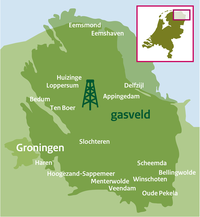
Photo from wikipedia
This paper reports for the first time a gas-sensitive nanohybrid based on octahedral molybdenum iodide clusters supported on graphene flakes (Mo6@Graphene). The possibility of integrating this material into two different… Click to show full abstract
This paper reports for the first time a gas-sensitive nanohybrid based on octahedral molybdenum iodide clusters supported on graphene flakes (Mo6@Graphene). The possibility of integrating this material into two different transducing schemes for gas sensing is proposed since the nanomaterial changes both its electrical resistivity and optical properties when exposed to gases and at room temperature. Particularly, when implemented in a chemoresistive device, the Mo6@Graphene hybrid showed an outstanding sensing performance toward NO2, revealing a limit of quantification of about 10 ppb and excellent response repeatability (0.9% of relative error). While the Mo6@Graphene chemoresistor was almost insensitive to NH3, the use of an optical transduction scheme (changes in photoluminescence) provided an outstanding detection of NH3 even for a low loading of Mo6. Nevertheless, the photoluminescence was not affected by the presence of NO2. In addition, the hybrid material revealed high stability of its gas sensing properties over time and under ambient moisture. Computational chemistry calculations were performed to better understand these results, and plausible sensing mechanisms were presented accordingly. These results pave the way to develop a new generation of multi-parameter sensors in which electronic and optical interrogation techniques can be implemented simultaneously, advancing toward the realization of highly selective and orthogonal gas sensing.
Journal Title: ACS Applied Materials & Interfaces
Year Published: 2022
Link to full text (if available)
Share on Social Media: Sign Up to like & get
recommendations!